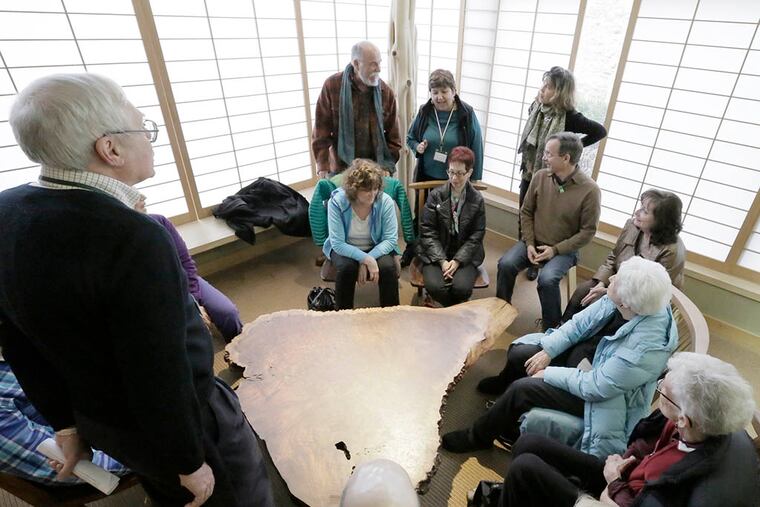At Michener Museum, seeing deeply into a work of art
The group had come to the Doylestown museum for a program that uses meditation to deepen the appreciation of art.

The group had come to the Doylestown museum for a program that uses meditation to deepen the appreciation of art.
But Maria Starr wasn't expecting the objet du contemplation to be a coffee table.
Yet there it was at the James A. Michener Art Museum: a tree trunk transformed by the famed George Nakashima Studio. Would deep breaths and a dose of mindfulness help illuminate the artistry in a walnut table as it had for a landscape painting?
Starr and 11 other museumgoers sat down around the table and closed their eyes.
Such hour-long sessions are the essence of "My OMEI: Observe Meditate Experience Internalize," the Michener's twice-a-month program that enlists visitors to slow down and devote 60 contemplative minutes to one work of art.
"Typically a [museum visitor] spends less than 60 seconds in front of an art object. They feel like they've paid their admission and want to make the most of it," said Sumreen Chaudhry of Philadelphia, a Temple University doctoral student who developed the program.
The object of My OMEI is to foster a personal experience with the object, forming a link between observer and work that lasts more than a minute and results in a deeper understanding of the art - and maybe even of the visitors themselves.
My OMEI, offered on the first and third Sunday of each month (with the exception of Easter), focuses on a new work each time. Featured artists have included John F. Folinsbee and Diane Burko.
Participants look at an artwork quietly for five minutes, then close their eyes and meditate for two minutes. Another time of quiet observance follows, eventually leading to group discussion.
During a session March 15, docent Steve Wisniewski instructed the visitors to touch as well as observe. Members of the group ran their fingers along the table's jagged edge and smooth surface.
"Now close your eyes and picture the piece with your mind's eye," Wisniewski said. Take "deep breaths and see if you notice anything new and interesting."
The program designed by Chaudhry has its roots in her own museum-going experiences and research that examines changes in the brain during meditation.
"Something happened to me when I was in a museum and would stand in front of a painting. I would feel exhilarated and excited and full of ideas, but completely calm at the same time," Chaudhry said.
She began to investigate when she studied as a graduate student at Johns Hopkins University in Baltimore. Chaudhry read research and interviewed neuroscientists about what happens to the brain during meditation.
A 2011 Massachusetts General Hospital and Harvard University study found that participants in an eight-week mindfulness meditation program showed physical changes in the brain.
MRIs detected increased gray-matter density in areas important for memory, learning, self-awareness, compassion, and introspection.
Chaudhry decided to design a program related to the research while she served as an intern at the Michener. She developed My OMEI in 2013.
The program became popular with visitors, who frequently returned for subsequent sessions, said Melissa Easton-Sandquist, the museum's group tours manager and education coordinator.
"It has really connected with people in a way that other public tours do not," Easton-Sandquist said. "I guess it is that quiet thinking time that is really meaningful . . . and sharing with other people."
On March 15, when the group members opened their eyes, the coffee table became more than a piece of furniture.
Starr, of Newtown, a program regular, saw the shape of an alligator's head. Gregg Gohen of Tinicum Township saw the continent of Africa and changes in terrain from north to south.
Later, visitors said the table evoked images of pulsating waves, and a heart that had been broken.
Jeanlu Ryersbach of Levittown focused on color and texture.
"When I look, I wonder where is my own darkness, light, and roughness," said Ryersbach, who attended with her husband, Robert H. Schram.
The group chatted around the table in the museum's Nakashima Reading Room, a serene space designed by the artist's daughter Mira Nakashima-Yarnall, who also created the table.
Starr had been in the room many times and seen the table frequently - but never like this.
"It's a deeper exercise," Starr said. "You see things that you've never seen before."
610-313-8211